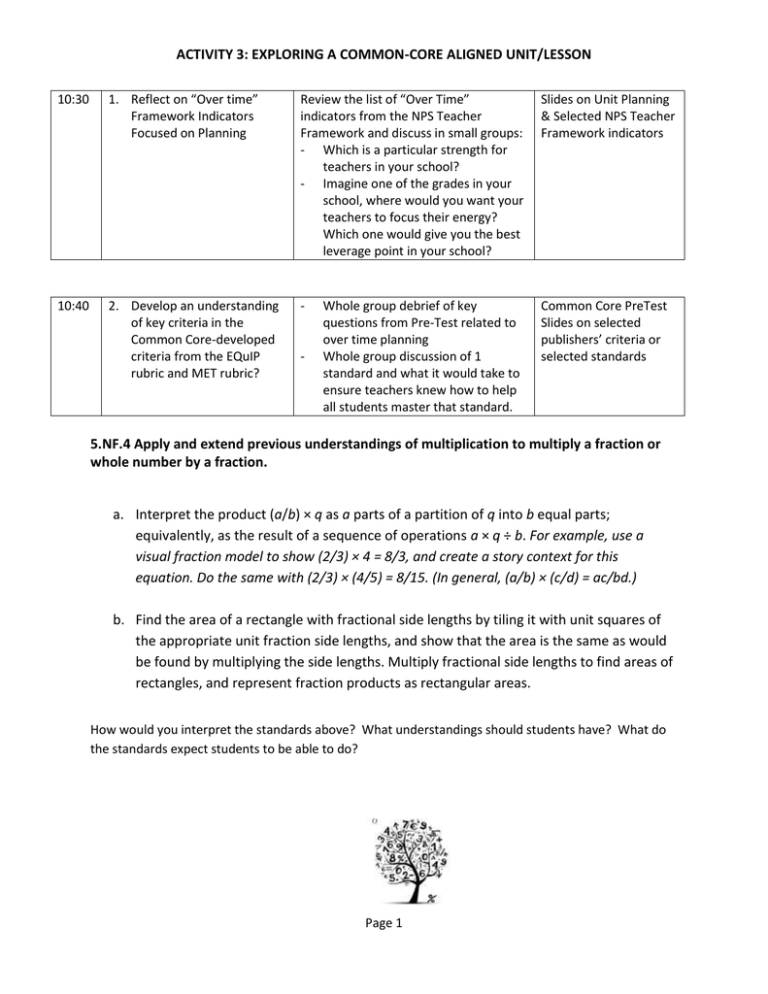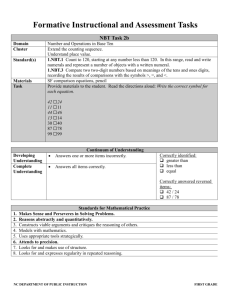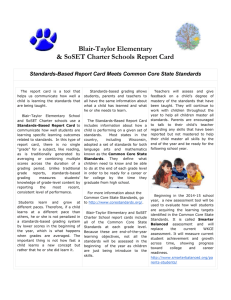ACTIVITY 3: EXPLORING A COMMON
advertisement

ACTIVITY 3: EXPLORING A COMMON-CORE ALIGNED UNIT/LESSON 10:30 1. Reflect on “Over time” Framework Indicators Focused on Planning Review the list of “Over Time” indicators from the NPS Teacher Framework and discuss in small groups: - Which is a particular strength for teachers in your school? - Imagine one of the grades in your school, where would you want your teachers to focus their energy? Which one would give you the best leverage point in your school? Slides on Unit Planning & Selected NPS Teacher Framework indicators 10:40 2. Develop an understanding of key criteria in the Common Core-developed criteria from the EQuIP rubric and MET rubric? - Common Core PreTest Slides on selected publishers’ criteria or selected standards - Whole group debrief of key questions from Pre-Test related to over time planning Whole group discussion of 1 standard and what it would take to ensure teachers knew how to help all students master that standard. 5.NF.4 Apply and extend previous understandings of multiplication to multiply a fraction or whole number by a fraction. a. Interpret the product (a/b) × q as a parts of a partition of q into b equal parts; equivalently, as the result of a sequence of operations a × q ÷ b. For example, use a visual fraction model to show (2/3) × 4 = 8/3, and create a story context for this equation. Do the same with (2/3) × (4/5) = 8/15. (In general, (a/b) × (c/d) = ac/bd.) b. Find the area of a rectangle with fractional side lengths by tiling it with unit squares of the appropriate unit fraction side lengths, and show that the area is the same as would be found by multiplying the side lengths. Multiply fractional side lengths to find areas of rectangles, and represent fraction products as rectangular areas. How would you interpret the standards above? What understandings should students have? What do the standards expect students to be able to do? Page 1 ACTIVITY 3: EXPLORING A COMMON-CORE ALIGNED UNIT/LESSON How would we use what we learned from the Pretest to explore and unpack the standards 5.NF.4a and 5.NF.4b? WARM UP STANDARD NOTATION What grade level is associated with the standards 5.NF.4a and 5.NF.4b? How do you know? What domain is addressed by standards 5.NF.4a and 5.NF.4b?? Q1 & Q2 CRITICAL AREAS How do standards 5.NF.4a and 5.NF.4b relate to the Major Work of the grade? Q4 RIGOR How, if at all, do standards 5.NF.4a and 5.NF.4b relate to the 3 aspects of rigor? Q12 COHERENCE/PROGRESSION List all of the requisite skills that relate to standards 5.NF.4a OF KNOWLEDGE and 5.NF.4b? (See pages 161 and 162) Q5 MULTIPLE REPRESENTATIONS Read Q5’s definition of Multiple Representations. Which representations are explicitly referenced within the standards 5.NF.4a and 5.NF.4b? Q6 TASK ANALYSIS Determine whether the following tasks align to the expectations of standards 5.NF.4a and 5.NF.4b. Why or why not? Page 2 ACTIVITY 3: EXPLORING A COMMON-CORE ALIGNED UNIT/LESSON 1. Multiply and express in simplest form. 3 8 2. Use the models above to find 1 2 of x 1 2 3 4 3. Drew has 4/5 gallons of paint and uses ¼ of it to paint one wall. How much paint did he use? How much paint is left? Page 3 ACTIVITY 3: EXPLORING A COMMON-CORE ALIGNED UNIT/LESSON 11:00 3. Explore how the Common Core criteria connect to the NPS Teacher Framework. See-Think-Wonder: Review the Note-taking Template and discuss in small groups: - What do you see in the note-taking template? What do you think? What questions do you have? - Address 2 questions as a group. Note-taking Template 11:15 4. Determine how selected CCSS-Aligned lessons and units are organized. Presentation on the key components of a Math in Focus Unit - Walk participants through the highlighted components of the selected curricular documents. Sample unit or module from Math in Focus To address “Coherent Planning,” read Planning Guide pages 160F and 160G then review the Grade 5 Assessment Framework’s content headlines to see how standards are addressed over the course of the year. 11:25 5. Analyze a selected CCSSAligned unit with the Common Core Planning “Note-Taking Template” Present to the group on how to evaluate the sample unit/lesson based on the first indicator (1e Coherent Planning) Ask participants to form small groups and assign two indicators to each group 6-7 small groups of 3 people each. Note-taking Template + Unit To address the remaining questions, review pages 160 -164 (Chapter Intro) and pages 165 – 168A (Lesson 4.1); Look for features that are inherent in a CCSSM-aligned unit/lesson: Visualization and use of pictures, models, and diagrams, fewer topics in greater depth, resources for differentiation, mathematical problem solving at the core, opportunities for students to ‘learn’, ‘consolidate thinking’ through practice’, and ‘apply,’. Determine how your assigned indicators are addressed within the lesson. Use the next page to help guide your thinking. Page 4 ACTIVITY 3: EXPLORING A COMMON-CORE ALIGNED UNIT/LESSON Learning Progression Pgs 161 – 162: Recalling Prior Knowledge (w/explanations) Pgs 162 – 164: Quick Check Depth of Knowledge Emphasis on Conceptual Understanding (Understanding multiplication of fractions) and Procedural Skill (using algorithms to find the product of two fractions) High Expectations for All Pg 165: Using Models…. Pg 166: Removing the Models Understanding Growth Pg 164: Pretest Use of Data Pg 164: Pretest, Let’s Practice Questions & Tasks; Precision & Evidence Teach and Learn Sections Tailored Instruction Pg 165: Reteach, extra Practice, Interactive Lessons, Guided practice,; Teach then Learn approach Pg 167: Hands On **Enrichment Guide 11:55 6. Final Debrief Ask each group to share one key takeaway Possible Reflection Questions: • What still needs to be defined for you? List the words and ideas. • What are the messages behind these materials? • What do you need help with? Page 5 Slide with reflection questions (Slide 62) ACTIVITY 3: EXPLORING A COMMON-CORE ALIGNED UNIT/LESSON Units Addressed In-Depth Standard(s) Math In Focus Sections Go Math Sections Module(s) Content Headline Assessment Cycle 1 Assessment Cycle 2 Assessment Cycle 3 November 7 – November 19 January 13 – January 24 March 19 – April 11* Assessment Cycle 4 May 28 – June 7* 1A, 1B 2A, 2B 3, 4, 5 6, 7, 8 5.NBT.1, 5.NBT.6 5.NBT.1, 5.NBT.6 5.NF.2, 5.NF.4 5.NF.2, 5.NF.4, 5.MD.5 Chapter 1, Chapter 2 8.0, 8.1, 8.2, 8.3 9.0, 9.1, 9.2, 9.3, 9.4, 9.5, 9.6 3.0, 3.1, 3.2, 3.3, 3.4, 3.5, 3.6, 3.7 4.1, 4.2, 4.3, 4.4, 4.5 Comments: 22 days Include review an module work 1.1, 1.2, 1.3, 1.4, 1.5, 1.6, 1.7, 1.8, 1.9, 1.10, 1.11, 1.12 2.1, 2.2, 2.3, 2.4, 2.5, 2.6, 2.8, 2.9 Comments: 18 days Include review an module work 3.1, 3.2, 3.3, 3.4, 3.5, 3.6, 3.7, 3.8, 3.9, 3.10, 3.11, 3.12 4.1, 4.2, 4.3, 4.4, 4.5, 4.6, 4.7, 4.8 5.1, 5.2, 5.3, 5.4, 5.5, 5.6, 5.7, 5.8 Chapter 10 Comments: 16 days Include review an module work 6.1, 6.2, 6.3, 6.4, 6.5, 6.6, 6.7, 6.8, 6.9, 6.10 7.1, 7.2, 7.3, 7.4, 7.5, 7.6, 7.7, 7.8, 7.9, 7.10 8.3 4.6, 4.7 11.2 13.1, 13.3, 13.5 15.4, 15.5, 15.5a, 15.5b Comments: 20 days Comments: 34 days Clarity needed on whether or not to include chapter 10 Comments: 22 days Comments: 19 days 5.NF.3, 5.NF.1-2 , 5.NF.4 Seeing Fractions as Division: multi-digit whole numbers; decimals to hundredths; symbolic notation in expressions N/A Division: fractions Comments: 23 days Include review an module work 5.NBT.1-2 Place Value: Multidigit Whole #’s Performing Operations: multidigit whole numbers; decimals to hundredths; symbolic notation in expressions 5.NBT.1-2 Place Value: decimals Performing Operations: decimals Addition and Subtraction: fractions with unlike denominators Multiplication: fractions * DATES WILL BE ADJUSTED. Page 6 8.1, 8.2, 8.4, 8.5 9.1, 9.2, 9.3, 9.4, 9.5, 9.6, 9.7 11.5, 11.6, 11.7, 11.8, 11.9, 11.10, 11.11, 11.12 Understanding Volume Ordered Pairs and The Coordinate Plane 2-D Figures





